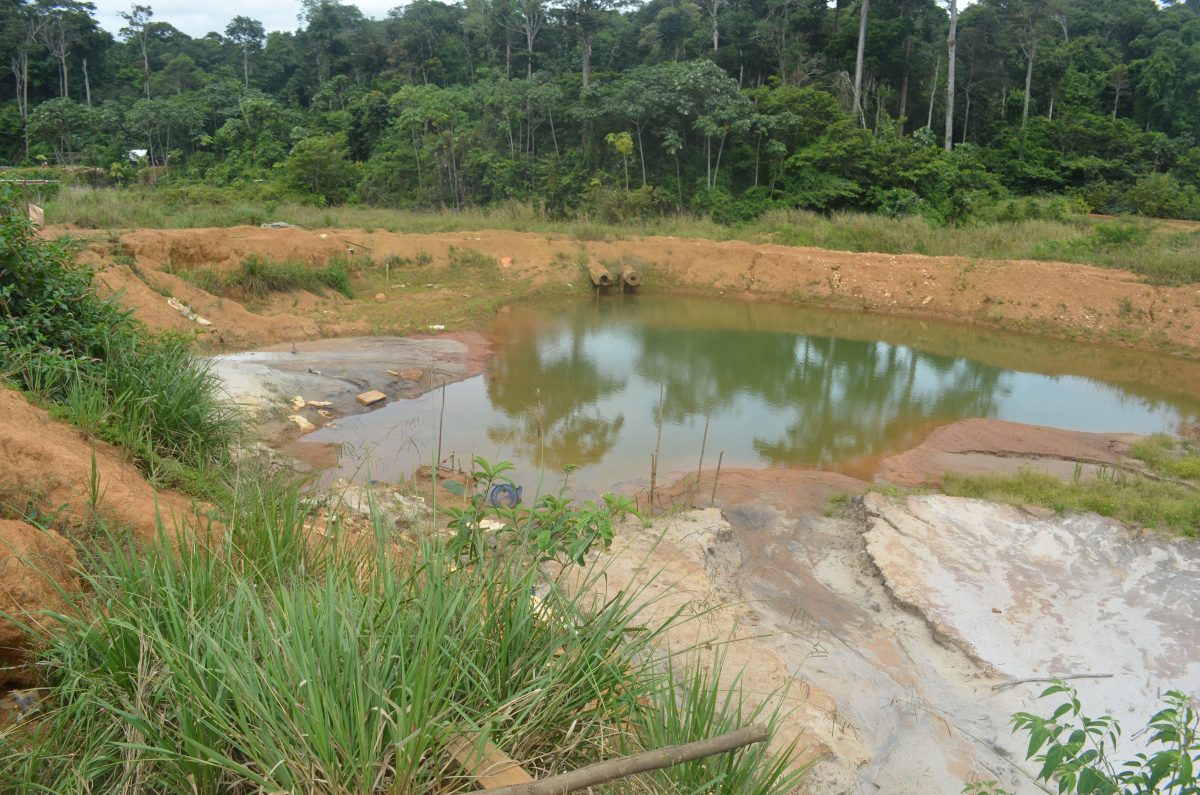It’s just past noon and the sound of chisels and hammers hitting against each other emanates from 150 feet below the top of Mazoa. The Mazoa Mountain, a peak in the Marudi mountain range in the Rupununi, has seen gold mining activities for decades, but its destruction only began a few years ago during a gold rush.
Over the years, miners flocked to the area with large machinery such as excavators, dredges, and mechanical crushers to mine for gold, and the influx produced severe environmental damage which is far from being reversed.
The prospecting results from Canadian gold mining firm, Guyana Goldstrike formerly known as Romanex Guyana Exploration Inc., which holds a legal claim over the majority of Marudi, has only exacerbated matters, luring miners to the area in search of valuable minerals.
Unsafe mining practices continue to threaten the Marudi mountain range, and though the destruction is fairly recent, residents believe that the damage was foretold.
“They call it, ‘Marutu Tao’ or Darkness Mountain because of a vision their Wapichan ancestors had many years ago,” Immaculata Casimero, a resident of Aishalton said during a visit by Stabroek News to the area. “The vision foretold that a darkness originating from Marutu Tao, or the mountain now known as Mazoa, will one day cover the land and bring great troubles to the Indigenous nations living in the area,” she continued.
Contamination of their freshwater supply and depletion of fish and wildlife populations due to mining activity has been viewed as fulfillment of this prophecy. Moreso is the slow but certain disappearance of the Mazoa Mountain. The destruction of the peak is one of the most significant environmental impacts mining has had in the area.
When Premchand Paul first arrived in the area approximately 32 years ago, the mountain was mostly untouched; there was little sign of deforestation and the creeks were flowing and teeming with life. After gold was discovered, an increasing number of persons ventured there in hopes of striking gold, their activity unhindered due to a lack of monitoring systems in Marudi at the time.
Paul is uncertain at what height the mountain stood before excavation began but told Stabroek News that that type of activity only stopped because the excavator struck a large rock. Of course, the relevant authorities were made aware of the gold rush and many of the small and medium scale miners were forced to clear off the mountain but by this time it was too late. The peak of the mountain was gone. However, the evident deterioration did not deter other miners, who then made tunnels in the mountains. To this day, mining activities continue in the area. Mazoa, Paul says, remains the Eldorado of the Marudi Mountains. He predicts that the complete destruction of Mazoa is inevitable.
Paul was quick to point out that the amount of destruction caused to these areas is not the fault of the small miners as they are not the ones who brought in the machines. Rather, he blames the owners of water and land dredges, and large-scale miners who have long left Marudi, skirting responsibility and leaving blame to fall on the artisanal miners.
Carving away
Today, only small groups of artisanal miners remain and mine manually. They spend several days carving away the surface of the tunnels, some using their metal detectors for guidance. It takes hours to collect the valuable dust, which later makes up their gold production after the raw materials are processed. All this is done in the most precarious conditions; using only a few pieces of timber placed between boulders to support the walls of the tunnels in hopes that they do not cave in.
At the foot of the mountain, another group of miners ply their trade with the use of small pumps and jet sprays.
The miners cannot put a figure to the amount of gold produced daily as the trade is an unpredictable one and some days are better than others. Although working in groups or pairs, it is everyone for themselves, as each collects their own portion of materials.
When Paul arrived, this was the norm. There were no excavators, dredges and crushers to aid extraction; everything was done manually. Over time, this changed, as miners sought easier ways to sustain their livelihood, though this brought considerable physical impacts.
The Indigenous nations occupying the area believe that unsafe mining practices have resulted in contamination of many rivers and creeks.
Casimero sits on the South Rupununi District Council (SRDC), an indigenous rights activist group which has been advocating for the protection of indigenous peoples’ rights and culture.
The Marudi Mountains are located in the South Rupununi of Region Nine, Guyana and are just one of a few areas in the Rupununi where gold mining activities occur. The Indigenous nations, which include the Wapichans, Wai-Wais and Macushi, living in the area believe that the mountains in the South Rupununi are the source of freshwater in the area.
This, Casimero said, is why they believe that their ancestors’ vision is coming to pass as the contaminated waters could result in health issues, the depletion of fish and wildlife, a staple of their diet, if it hasn’t already. However, a more potent manifestation for the residents that the vision is coming to pass, is the slow but certain disappearance of the Mazoa Mountain. The destruction of the Mazoa mountain peak is one of the most significant environmental impacts mining has had in the area. The activities over the years have eaten away a vast portion of the land destroying not only the environment but the cultural significance of the area to the Wapichan Nation
“In 2012, I could have walked and when it went 2014/2015 I had to walk around the entire thing to get to the throne it was just this huge, huge hole. It was disturbing for me to see that,” she told Stabroek News.
With the lands not a part of any indigenous community and currently regarded as state lands, the indigenous people are unable to prosecute anyone.
Casimero, nonetheless says that under the proposed land extension of her village Aishalton, the mountain and hill fall within the boundaries.
The destruction she points out has been upsetting to the people from her nation but little has been done by successive governments to stop damage.
“We are not against mining because people too depend on it, but we are saying that before mining on any of our land, can we have consultations? Can we sort our land issues before any mining?” she questioned.
“When I first came here, the Locust Creek was flowing and now people who come here think that it is just a spring but it is not. It was a creek filled with flowing water. The Creek and everything that lived inside were victims of mining,” Paul recalled, before noting that since his relocation to the area, Marudi has become a tremendously different place.
Manual labour
Paul recalled that there were no excavators, dredges and crushers and so miners would have to do the manual labour to extract gold. This was hard but with nowhere else to get an income, the job was done.
Over time, however, this changed. Dredges, excavators and mechanical crushers were brought in to make mining activities easier.
Speaking of the disappearance of creeks, people kept discovering gold along the banks of the creeks and this would result in mining pits being dug. This stopped the waters from flowing. Eventually, he said, Locust Creek became an almost-dried spring which is contaminated with mercury. During a visit to the area, it was observed that persons had set up a water dredge at the spring, which signalled the complete destruction of what was once known as the Locust Creek.
In addition, Paul said that almost all the creeks and surrounding lands were contaminated as many persons used silver and mercury to extract the gold. When mercury is brought into contact with gold particles in sediments or crushed ore, it forms what is called an “amalgam” – a soft mixture of roughly 50% mercury and 50% gold. To recover the gold from the amalgam, it is heated to vaporise the mercury, leaving the gold behind. Mercury is released into air, water, and soil in several of the steps of this process.
Paul said that although this is illegal, many persons continue to use this process to extract gold because they are not being monitored and release the mercury into the soil, air and waterways. He opined that mercury can be found in any of the nearby ponds, creeks and soil in the area because of its consistent use during mining.
He stated that he is not in favour of mercury being used to capture the gold because it states in the mediation agreement between Romanex, the Rupununi Miners Association (RMA) and the SRDC that mercury should not be used to extract gold on the Romanex mining concession.
Major deforestation can be found in the Marudi and Toucan mountains. While small trees are now beginning to reclaim the land destroyed by mining activities, other areas remain bare and desolate with little hope for forest recovery.
The environmental impacts have been grave resulting in significant destruction to wildlife habitats, healthy forest, clean creeks and rivers, and contaminating the air.
In April of 2019, the then Ministry of Natural Resources had said that contrary to claims, Minister of Natural Resources Raphael Trotman did not give permission to any miner to conduct mining operations on Mazoa. There were enforcement operations around that period in the Marudi Mountains to remove illegal miners. It is unclear what steps have been taken since then by the authorities to protect the area from indiscriminate mining.















